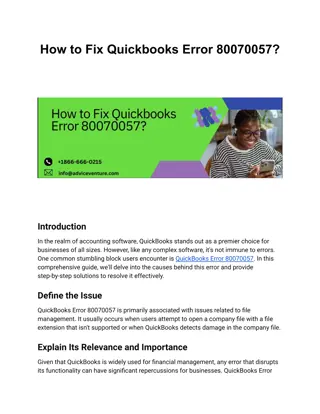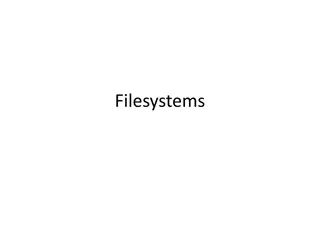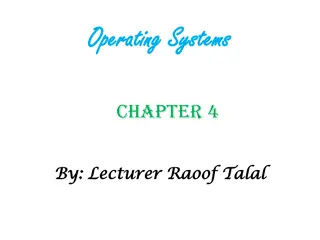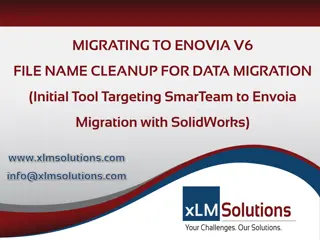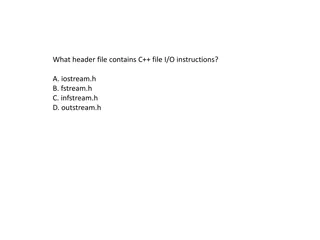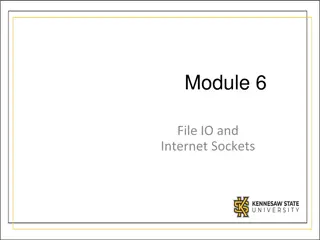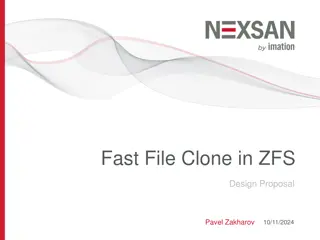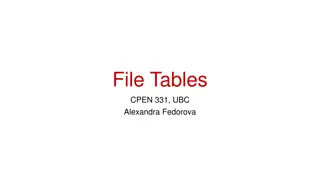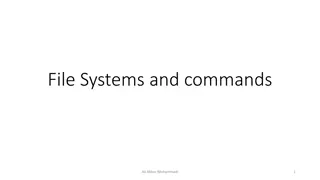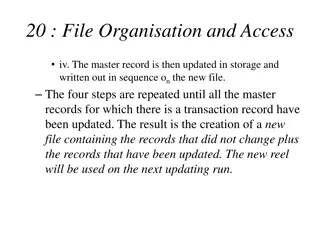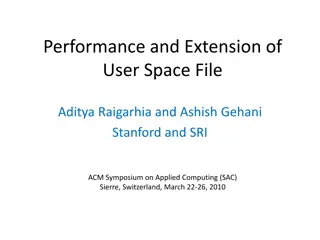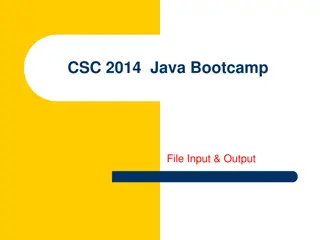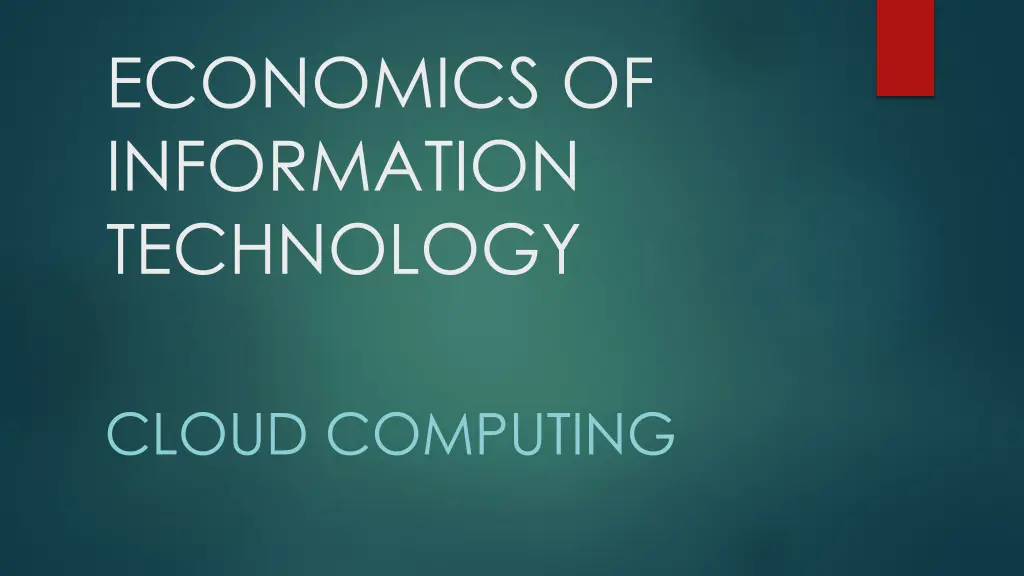
Understanding Cloud Computing: Economics, Benefits, and Examples
Explore the concept of cloud computing, its economic advantages, and real-world examples. Discover how cloud services work, why it's called cloud computing, and deployment options like public cloud. Learn how businesses can leverage cloud technology for innovation, scalability, and cost-efficiency.
Uploaded on | 0 Views
Download Presentation

Please find below an Image/Link to download the presentation.
The content on the website is provided AS IS for your information and personal use only. It may not be sold, licensed, or shared on other websites without obtaining consent from the author. If you encounter any issues during the download, it is possible that the publisher has removed the file from their server.
You are allowed to download the files provided on this website for personal or commercial use, subject to the condition that they are used lawfully. All files are the property of their respective owners.
The content on the website is provided AS IS for your information and personal use only. It may not be sold, licensed, or shared on other websites without obtaining consent from the author.
E N D
Presentation Transcript
ECONOMICS OF INFORMATION TECHNOLOGY CLOUD COMPUTING
GROUP MEMBERS NAMES REGISTRATION NUMBER JACKLINE WATETU 1041991 CHRISTINE NJERI 1042018 PAULINE WAWIRA 1042017 DAVID PARACH DENG 1039940
What is cloud computing? It is the delivery of on demand computing services from application to storage and processing power over the internet to offer faster innovation ,flexible resources and economics scale.
WHY IS IT CALLED CLOUD COMPUTING. A fundamental concept behind cloud computing is that the location of the service and many of the details such as the hardware or operating system on which its running are largely irrelevant to the users. Instead of buying, owning, and maintaining physical data centers and servers, you can access technology services, such as computing power, storage, and databases, on an as-needed basis from a cloud provider like Amazon Web Services (AWS). That is why the name cloud is used to denote it didn t matter-it was just a cloud of stuff.
How cloud computing works Instead of buying, owning, and maintaining physical data centers and servers, you can access technology services, such as computing power, storage, and databases, on an as-needed basis from a cloud provider like Amazon Web Services (AWS). Firms can avoid up front cost and complexity of owning and maintaining their own IT infrastructure and instead simply pay for what they use and when they use it.
EXAMPLES OF CLOUD COMPUTING Cloud computing has a vast number of services , that include consumer services such as Gmail and google photos. Netflix relies on cloud computing services to run its videos streaming services. Cloud computing is becoming default option for many apps; software vendors are increasingly offering their application services over the internet rather than a standalone product as they try to switch to a subscription model.
Deployment of cloud service Deployment means to describes the way a cloud platform is implanted and hosted and who can access it. 1.PUBLIC CLOUD. -Its a type of cloud hosting that allows the accessibility of systems and it services to it client easily for example Amazon and google. -Server infrastructure belongs to service providers that manage them and administer resources which is why there is no need for users company to buy and maintain their hardware It is also a first choice for business that operate within the industry with low of privacy concerns.
2. PRIVATE CLOUDING It is also called internal or corporate cloud. They are only utilized by a single organization and only an authorized users who can access, utilize and store data in private cloud thus providing the organization greater control over data and security Business that have dynamics, critical, secured, management demand based requirement should adopt private cloud.
3. HYBRID CLOUDING. This is a combination of two or more cloud server that is private, public or community combined as one but remain as individual entities. Hybrid cloud deployment model not only safeguards and controls important strategic assets but does so in most cost and resource effectively possible for each specific case. Also this approach facilitates data and application portability. It s advantage is that it is flexible.
4. COMMUNITY CLOUD it resembles a private cloud but the difference is the set of users. A private cloud implies that only one company own the server in the case of community cloud, several organizations with similar background share the infrastructure and related resources for example the research organizations and ventures. This helps in reduction of cost.
TYPES OF CLOUD SERVICE Infrastructure as a service (IaaS) Infrastructure as a service offers the fundamental infrastructure of virtual servers, network, operating systems and data storage drives. It allows for the flexibility, reliability and scalability that many organizations seek with the cloud, and removes the need for hardware in the office. This is because the lower end of managed cloud computing services where hardware resources are provided by an external provider and managed for you. This makes it ideal for small and medium sized organizations looking for a cost-effective IT solution to support business growth. IaaS is a fully outsourced pay-for-use service and is available as a public, private ,community or hybrid infrastructure.
PLATFORM AS A SERVICE (PAAS) Platform as a service is an advanced version of IaaS. Apart from just providing the IT infrastructure, PaaS also provides the computing platform and solution stack as a service. PaaS is a cloud computing service that provides developers with a framework that can be used for building custom applications. Platform as a Service lets software developers build custom applications online without having to worry about data storage, data serving, and management. Examples of PaaS solutions include Microsoft Azure
SERVER LESS COMPUTERING Server less computing enables developers to build applications faster by eliminating the need for them to manage infrastructure. Server less computing allows developers to purchase backend services on a flexible pay-as-you-go basis, meaning that developers only have to pay for the services they use. With server less applications, the cloud service provider automatically provisions, scales, and manages the infrastructure required to run the code. A server less approach offers developers, teams, and organizations a level of abstraction that enables them to minimize the time and resources invested in infrastructure management. Every component of an application benefits from this approach, from computing and the database engine to messaging, analytics. Using an end-to-end server less platform that provides a comprehensive set of server less technologies is the best way to ensure that the organization gains the maximum benefit from going server less.
SOFTWARE OF A SERVICE(SaaS) It is a special cloud computing service that incorporates both IaaS and PaaS service offerings. This cloud computing solution involves the deployment of software over the internet to various businesses who pay via subscription or a pay-per-use model. It is useful to those business that need a lot of web or mobile access such as mobile sales management software. It also provides a provision to the users to end the subscription when it is no longer needed. SaaS is managed from a central location so businesses don t have to worry about maintaining it themselves, and is ideal for short-term projects.
USES OF CLOUD COMPUTING If you use an online service to send email, edit documents, and watch movies you are using cloud computing. 1.Create cloud-native application Its quickly build, deploy and scale applications. 2.Test and build application reduce application development, cost and time by using cloud infrastructure that can be easily be scaled up and down 3.Stores, backup and retrieve data protect your data more cost efficiently and at massive scale by transferring your data over the internet to an offsite cloud storage system, that is accessible any time
4. Analyze data It unify your data across team divisions and location in the cloud then use cloud service such as a machine learning and artificial intelligence to uncover insight for more informed decisions 5.Stream audio and video it connects with the audience anywhere, anytime with on a device with a high definition video and audio with global distribution 6. Deliver software on demand offers the latest software version and updates around the customers anytime they need and wherever they are.
ADVANTAGES OF CLOUD COMPUTING Reduces information technology cost. Cloud computing reduce the cost of managing and maintaining your IT systems. Rather than purchasing expensive systems and equipment for your business, you can reduce your costs by using the resources of your cloud computing service provider. You may be able to reduce your operating costs because: You no longer need to pay wages for skilled staff. The energy consumption cost will be reduced. 1. 2. Availability .Most cloud provider are reliable in offering their services 24/7 . Therefore , one can get the application anytime and anywhere . Some of the application even function offline. Security Cloud computing offers great security when any sensitive data has been lost. As the data is stored in the system, it can be easily accessed even if something happens to your computer. You can even remotely wipe out data from the lost machines for avoiding it getting in the wrong hands Control on the Documents Before cloud came into being, workers needed to send files in and out as the email attachments for being worked on by a single user at one time ultimately ending up with a mess of contrary titles, formats, and file content. Moving to cloud computing has facilitated central file storage..
DISADVANTAGES OF CLOUD COMPUTING Risk of data confidentiality .There is always a risk that user data can be accessed by other people. So data and cloud protection must be good because if it won t be dangerous for data confidentiality. Technical problem . The use of Cloud Computing makes you able to manage it yourself when there is a problem, you must contact customer care who is not necessarily ready 24/7. This is a problem because for some support you also have to pay more money. Lack of Expertise Cloud computing requires capable personnel in order to manage the system. The lack of expertise of these staff indirectly leads to two major problems: security and cost management . Lack of expertise is an issue when solved, can lessen the problems of security and unnecessary expenses. This can be done through constant training and certification of personnel in order to keep them updated with the latest developments in the system they are entrusted with. Developing a team of technological experts instead of mere technological workers can aid the problems that arise out of lack of expertise. The more complex the technology becomes, the more your business should invest in the capability of your IT team.
REFERENCES www.azure.microsoft.com www.leadingedgetech.co.uk www.exitcertified.com www.cloudflare.com

